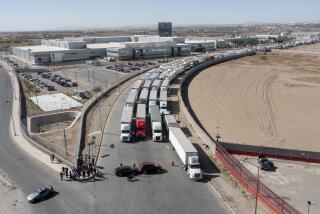Dollar can’t buck the peso’s steady ascent
MEXICO CITY — The super peso is back.
As rising interest rates draw capital south of the border, Mexico’s currency is trading near a six-year high against the U.S. dollar and is poised to crack the psychological 10-peso-to-the-buck barrier. The peso closed at 10.007 per dollar Wednesday, compared with 10.07 on Tuesday. The peso has gained about 9% against the greenback this year.
The last time a dollar bought fewer than 10 pesos was October 2002.
The pumped-up peso is making U.S. goods cheaper for Mexican consumers. But it’s bad news for American tourists, for whom a visit south of the border is becoming costlier. The rising peso is also cutting into Mexican exporters’ profits and making it costlier for U.S. businesses to set up shop in Mexico.
Richard Jaime, president of North American Production Sharing Inc., said his clients were feeling the squeeze. The Del Mar, Calif., firm handles administrative chores for U.S. manufacturers outsourcing operations to Mexico. He said the strengthening Mexican currency had raised labor costs for his American clients because they sell their products in dollars but pay their Mexican workforce in pesos.
Jaime said many of his customers were automotive and electronics companies that can’t raise their prices in a slowing U.S. economy. That means the currency hit is coming out of their pockets. “Obviously our clients are paying attention because all their costs are going up,” Jaime said. “Everything from labor to materials is increasing tremendously.”
Blame it on the Bank of Mexico. Spooked by rising inflation, Mexico’s central bank is doing what the U.S. Federal Reserve has hesitated to: hike its benchmark overnight lending rate. It raised it to 8% last week, the second increase in a month.
The corresponding U.S. federal funds rate is 2%. That differential is fueling foreign demand for Mexican fixed-income securities, which are paying significantly higher rates of interest than those in the United States. Investment dollars are flowing into Mexico, which is helping to strengthen the peso.
With Mexican inflation showing few signs of easing, some analysts predict more rate hikes. “We have seen some pretty hawkish talk from the central bank,” said Gray Newman, senior Latin America economist with Morgan Stanley in New York. “That’s an important driver here.”
The strong peso could be a blow for Mexico’s tourism industry. The sector is already suffering fallout from higher fuel prices and an explosion of narcotics-related violence that has dissuaded millions of U.S. day-trippers from crossing the border.
A weakening dollar also means that Mexican families who depend on remittances sent by loved ones working in the United States end up with less cash once those greenbacks are converted into pesos.
Still, a strong national currency boosts the purchasing power of Mexican consumers. It’s particularly advantageous for those who live near the northern border and can cross into the United States, where their pesos are stretching further every day.
American retailers are eager to court this business. El Paso, Texas, depends heavily on shoppers from neighboring Ciudad Juarez, said Victor Venegas, marketing and outreach coordinator for the El Paso Economic Development Department.
He said a strong peso meant more business for places such as the Outlet Shoppes at El Paso.
“When the economic situation improves in Mexico, the economic situation improves in El Paso,” he said.
--
More to Read
Sign up for Essential California
The most important California stories and recommendations in your inbox every morning.
You may occasionally receive promotional content from the Los Angeles Times.










